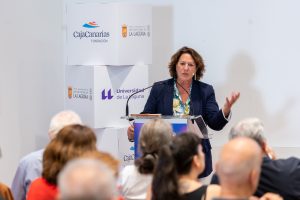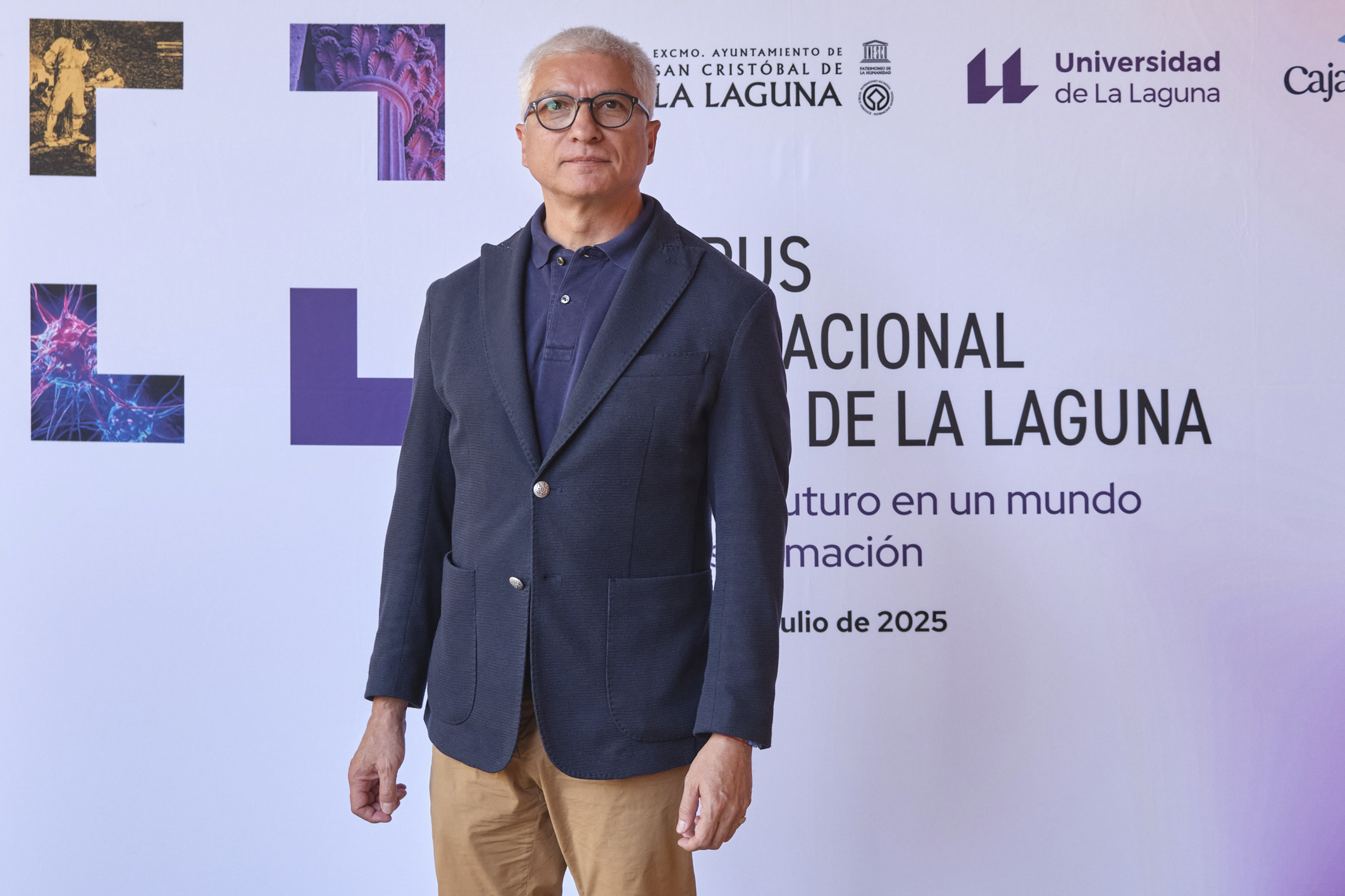Interview with Carmen Espegel, speaker at the course “The reason for being of heritage in the 21st century”

Carmen Espegel, Professor of Architectural Projects at the ETSAM (Madrid School of Architecture), is a leading voice in the study of heritage and its relationship to housing. She directs the "Collective Housing" Research Group and heads the firm Espegel Arquitectos, whose projects have received numerous awards.
During her participation in the first edition of the Ciudad de La Laguna International Campus, she delivered a lecture on the reinvention of built heritage to acknowledge the past, delving into the need to establish genealogies between architectural projects, history, and contemporary life. She also participated in the seminar "The Rationale for Heritage in the 21st Century," alongside other leading international experts such as Francesco Bandarin, Michael Jakob, Alejandro de Ávila Blomberg, Francisco Aznar, Juan Manuel Palerm, and José Luis Rivero, where she addressed heritage as a cultural, economic, and social driver from the perspective of conservation, protection, and innovation.
Taking as a reference point the thematic focus of the Campus in which you participated, what, for you, is the main idea that encompasses the challenges of heritage in the 21st century?
That, in a way, heritage connects everything: past, present, and future. It is very important to understand this because maintaining what already exists costs much less than creating something new. Traditionally, we have used heritage in many ways: not only by preserving buildings with historical value, but also by using them as building materials. We must not forget that, for example, the Colosseum was able to provide resources that allowed for the construction of much of Baroque Rome.
Today, it is crucial to understand heritage as a broader concept and expand it to include everything that exists, all the buildings that can be reclaimed and reused. Its role in the 21st century is fundamental: it contributes to the cultural, economic, and social configuration of our cities, providing identity and memory.
Throughout your international career, have you found significant differences in how different countries understand and approach built heritage?
Yes, views on heritage vary greatly across cultures. In North America, for example, heritage is considered "lesser" in the sense that these are younger countries with less accumulated historical legacy. Another example is the Eastern conception—I'm thinking of Japan, for instance—where a heritage building can be dismantled or demolished every few years and then rebuilt using the same techniques, materials, and procedures. There are very different ways around the world of understanding what it means to conserve heritage.
In her lecture, "Reinventing Built Heritage," she addressed the concept of tradition. What does working from tradition mean to you when designing contemporary architectural projects?
It's necessary to explore the past and our collective memory, but to do so actively. Participating in that tradition means becoming involved, grasping the essence of the project and not just the superficial aspects, which is what has often happened with heritage: we've wanted to preserve the external structures, but we've paid little attention to the interior, to the internal architecture. In reality, my proposal is to partner with heritage to continue building that history.
It's about identifying the genealogies that exist in terms of projects between the past, present, and future. Understanding that we are part of the same line of action, even though we live in different times, and that, from the perspective of contemporary architecture, we can also rewrite that historical heritage. We can reinterpret it, enhance its value, and reuse it.
For example, for me, there is nothing worse for heritage than an unused building. I understand that use is one of the most complex issues: to what extent certain old structures can support certain current functions. But I believe it's key to understand that heritage is the foundation from which we can continue building our history.
And on this topic, when you talk about establishing genealogies between projects, what criteria do you use to connect past and present in your designs?
It depends on the subject matter. I think the fundamental thing is to have a very good understanding of the material we're working with. And that can only be achieved through a detailed historical knowledge of the transformation processes, because often, when we work with heritage, we don't know which layer to focus on. That's why I'm a strong advocate for using them all; although I understand that, at certain times, we have to give more importance to one layer than another, to one period than another.
We see this constantly in our cities: sometimes we dismantle certain buildings to get to what we interpret as their origin, which is perhaps more Roman and less medieval. But, for me, the key is to know what we have in our hands very well, without that knowledge paralyzing us. We must understand the pre-existing structure as something that needs to be reused and interpreted, so that current users can understand and visualize it.
Furthermore, collective housing appears as a central theme in your career. What does this area contribute to your vision of the city and contemporary architecture?
We cannot talk about housing without talking about the city. Housing and city are one and the same, even though it may seem otherwise. Firstly, because it is the large residential population that truly builds the city. Monuments or iconic buildings are small embellishments, isolated elements; but what shapes the city is housing. That is why it is fundamental—key, even radical—to understand that housing and city are intimately linked.
Moreover, today housing has lost many of the functions it once had. In the past, soap was made at home, children were taught, clothes were made… there were a great many activities that have now moved to the urban space. Currently, the city provides us with these services; we no longer need them within the home. Therefore, the symbiosis between home and city is crystal clear.
Today we can go to the gym, buy prepared food, or order delivery. We can even imagine homes without kitchens, since needs have changed and many young people hardly cook at all. The same applies to bathrooms: gyms with large restrooms and communal showers could lead to a transformation of housing in the future.
I believe that understanding the city and housing as a single system is essential for what lies ahead.
After participating in the first edition of the International Campus Ciudad de La Laguna, how would you generally rate your experience?
It was incredibly interesting because there were so many different points of view, and I think that's the best thing about these scientific meetings: the diversity of perspectives forces you to re-examine your own convictions and realize that there are many ways to engage with heritage. My colleagues were excellent, and honestly, I found it to be a wonderful moment of debate, of intense intellectual exchange, enriching and truly important.
And I think the public appreciated it too, as several people came up to congratulate us. They found it very valuable that this debate was taking place in a city like San Cristóbal de La Laguna, which has such a rich heritage.
Regarding your participation in the Campus… What are the main conclusions you draw from your participation in the seminar 'The Rationale for Heritage in the 21st Century'?
First, there are many ways of looking at things, and each person must develop their own critical perspective after engaging with these different ways of understanding heritage. Second, heritage is a value, both increasingly important and essential. Because, as I often say, it's like entering a path already built and adding our own time to that journey. I think it's ultimately about understanding humanity as a long, continuous path.
For me, that was the most powerful aspect: understanding that heritage can be analyzed from very diverse perspectives, even from very innovative approaches.
The CICOP Foundation, based in the Canary Islands, promotes heritage conservation and enhancement projects in various countries. How do you think local initiatives can influence and transform the global vision of heritage conservation?
I'm particularly interested in seeing that barrier between the global and the local disappear. I believe that general theories can be developed from very specific territories. The local is wonderful when it's able to transcend and project itself into other territories, even international ones, as we've seen. In the 20th century, grand theories were formulated based on generalizations, losing sight of many particularities. And I find it very insightful to consider the opposite approach: starting from the particular to arrive at the general, instead of going from the general to the particular, as happened then.
The 20th century was one of grand generalities regarding heritage; however, now the focus is more on particularities, on what is unique, even on anomalies. And I think that, through them, we can better understand our own existence.
Looking to the future, what urgent challenges do you see in the preservation and activation of heritage, both tangible and intangible?
There are very significant challenges. I believe that tourism is, and has long been, one of the greatest challenges in heritage conservation, as it can be a major threat. We must be extremely careful, because we can destroy this heritage value through misuse or poor planning.
Undoubtedly, we must seriously consider what to do with it. There are many alternatives and diverse solutions, such as the Altamira Neocave. We don't all need to go inside to see all the originals; in fact, many times we don't even understand them. Some people understand more, others less, but in general, we don't grasp the full complexity of what is shown to us. And, moreover, we can destroy it: with our footsteps, our sweat, our body heat. That's why this is a crucial issue.
Another important challenge is the destruction caused by war. We have seen it: heritage also becomes another weapon in the conflict.












